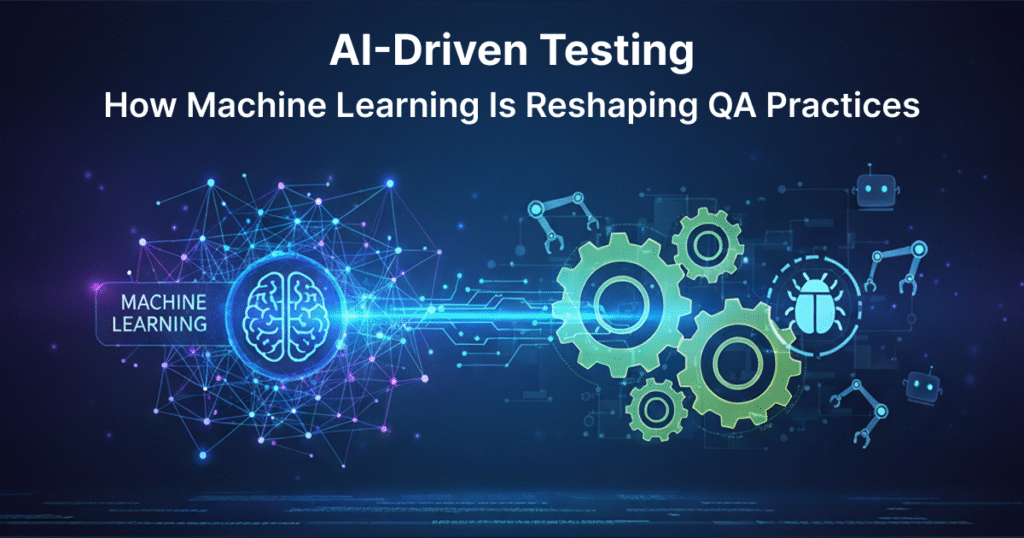In today’s fast-paced software world, ensuring application quality is more critical than ever. Traditional testing methods, while effective in the past, often struggle to keep up with rapid development cycles, frequent updates, and increasingly complex systems. This is where AI-driven testing comes in, leveraging machine learning (ML) to make quality assurance smarter, faster, and more reliable. By combining automation with intelligent analytics, AI is helping QA teams not just detect issues, but predict and prevent them before they affect end users.

What is AI-Driven Testing?
AI-driven testing uses machine learning algorithms to automate and enhance software testing. By analyzing historical data, past test results, and code changes, AI can:
1.Predict potential defects in the system.
2.Optimize test cases for maximum coverage.
3.Automate repetitive QA tasks, freeing testers for more complex work.
The result is faster testing cycles, higher accuracy, and reduced operational costs. Some of the key capabilities include:
Automated Test Case Generation: AI can automatically identify and create test cases based on how the application behaves in different scenarios.
Predictive Defect Detection: Machine learning models can detect areas of code that are prone to bugs before they cause failures.
Self-Healing Scripts: When application interfaces change, AI adjusts the test scripts automatically, reducing maintenance overhead.
Anomaly Detection: AI can continuously monitor test results to detect unexpected behavior or performance issues.
Why AI and ML are Changing QA
AI and ML are no longer optional—they are transforming how QA teams operate. Here’s why organizations are investing heavily in AI-driven testing:
Speed and Efficiency: AI can execute thousands of test cases in parallel, reducing time-to-market for software releases.
Improved Accuracy: Automated predictions and anomaly detection reduce human error, leading to more reliable results.
Resource Optimization: Testers can focus on exploratory testing and edge-case scenarios rather than repetitive tasks.
Proactive Testing: Predictive analytics allow teams to identify potential problems before they impact end users.
Industry reports show that companies adopting AI-driven QA have reduced testing cycles by up to 40% and significantly improved defect detection rates.
Challenges in Implementing AI-Driven Testing
Despite its benefits, integrating AI into QA comes with challenges:
Model Reliability: AI models must perform accurately across different applications and environments.
Bias and Fairness: Algorithms must be trained to avoid unintended biases that could skew test outcomes.
Integration Complexity: Combining AI tools with existing CI/CD pipelines requires careful planning.
Skill Requirements: QA teams must understand both testing fundamentals and AI concepts to fully leverage these tools.
Overcoming these challenges requires careful planning, collaboration, and continuous monitoring. Companies often start small, piloting AI tools on critical modules before expanding organization-wide.
Best Practices for AI-Powered QA
To effectively leverage AI, organizations should follow these best practices:
1.Collaborate Across Teams: Ensure developers, QA engineers, and data scientists work together from the start of the project.
2.Document AI Processes: Maintain transparency on how AI models generate test results and influence decisions.
3.Continuous Evaluation: Regularly assess AI models for accuracy, fairness, and relevance.
4.Focus on ROI: Prioritize AI testing for areas that provide the highest value, such as high-risk features or critical workflows.
5.Combine AI with Human Insight: While AI excels at automation, human judgment is essential for complex test scenarios and ethical considerations.
Real-World Applications
AI-driven testing is already transforming industries across the globe:
Healthcare: AI tools test applications for compliance with strict regulations and ensure patient data security, especially in telemedicine platforms.
Finance: Machine learning helps detect potential fraud, verify transaction accuracy, and ensure regulatory compliance.
E-commerce: AI assists in testing user interfaces, payment gateways, and order processing systems to enhance customer experiences.
Telecommunications: Predictive testing identifies network vulnerabilities before customers experience downtime.
These examples demonstrate that AI-driven QA isn’t just theoretical—it’s delivering tangible business outcomes.
Emerging Trends in AI-Driven Testing
The future of QA is closely tied to AI advancements. Key trends include:
Smarter AI Models: Enhanced predictive analytics will improve test accuracy and reduce false positives.
Greater Automation: AI will increasingly handle complex testing tasks, including performance, security, and regression testing.
Integration with DevOps: AI-driven testing is becoming an integral part of continuous integration and continuous delivery (CI/CD) pipelines.
AI-Assisted Decision Making: QA teams will rely on AI to prioritize testing efforts and make strategic decisions about release readiness.
Ethical AI in QA: Companies are paying more attention to fairness, transparency, and regulatory compliance when implementing AI in testing.
How to Implement AI-Driven Testing in Your Organization
Bringing AI into your QA practice isn’t just about buying a tool — it’s about aligning people, processes, and technology. Here’s a roadmap:
1.Assess Current Testing Maturity
Review your existing QA processes, automation coverage, and data quality.
Identify repetitive or high-volume areas where AI can add value first.
2.Start with a Pilot Project
Pick a low-risk application or module and experiment with AI-based tools.
Measure time savings, defect detection, and stability before scaling.
3.Select the Right Tools and Frameworks
Evaluate platforms such as Testim, Mabl, Applitools, or Functionize.
Consider integration with your CI/CD pipeline and existing automation suite.
4.Build Cross-Functional Teams
Encourage collaboration between QA engineers, developers, and data scientists.
Train staff on interpreting ML predictions and maintaining AI models.
5.Establish Governance and Ethics
Document how AI makes testing decisions and ensure explainability.
Set up guidelines for monitoring bias, data privacy, and security.
6.Scale Gradually
Once the pilot proves ROI, roll out AI testing across projects and business units.
Continuously fine-tune models using fresh data and feedback loops.
Measuring Success with AI-Driven Testing
Implementing AI is only part of the journey — measuring its impact is key. Common metrics include:
Defect Detection Rate (DDR): How accurately AI spots potential bugs.
Test Coverage: Percentage of code or functionality evaluated by AI tools.
Cycle Time Reduction: How much AI shortens testing and release cycles.
Cost Savings: Lower maintenance costs thanks to self-healing scripts and automation.
Popular AI Testing Tools and Frameworks
A growing ecosystem of tools is making AI-driven QA accessible:
Testim & Mabl: AI-powered platforms for web app testing with self-healing capabilities.
Applitools Eyes: Uses visual AI to validate UI and detect subtle layout changes.
Functionize: Combines ML with cloud execution for large-scale test automation.
ReportPortal: Adds AI to log analysis, helping teams identify failures quickly.
Human–AI Collaboration in QA
While AI accelerates testing, human insight remains essential. QA engineers interpret results, refine ML models, and evaluate ethical aspects such as fairness and bias. Successful organizations view AI as a partner rather than a replacement, blending automation with human creativity and critical thinking.
Conclusion
AI-driven testing is reshaping quality assurance by making it faster, smarter, and more proactive. While challenges like model reliability, bias, and integration complexity exist, the benefits of AI far outweigh the risks. By following best practices and combining AI insights with human judgment, organizations can significantly enhance software quality, reduce costs, and accelerate delivery.
As software systems continue to grow in complexity, AI and machine learning will play a pivotal role in ensuring that applications are not just functional, but reliable, secure, and user-friendly. Embracing AI-driven QA is no longer a choice—it’s a necessity for modern software development.
Search
Categories

Author
-
Sakthi Raghavi G is a QA Engineer with nearly 2 years of experience in software testing. Over the past year, she has gained hands-on experience in Manual Testing and has also developed a foundational understanding of Automation Testing. She is passionate about continuous learning and consistently takes ownership to drive tasks to completion. Even under high-pressure situations, she maintains focus and productivity often with the help of her favorite playlist. Outside of work, Sakthi enjoys exploring new experiences and staying active by playing badminton.
